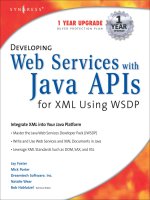Excel macros excel macros and VBA
Bạn đang xem bản rút gọn của tài liệu. Xem và tải ngay bản đầy đủ của tài liệu tại đây (3.07 MB, 42 trang )
VBAANDMACROS
VBAisamajordivisionofthestand-aloneVisualBasicprogramminglanguage.Itis
integratedintoMicrosoftOfficeapplications.ItisthemacrolanguageofMicrosoftOffice
Suite.Previouslyitwasknownasxlm.
HowtoaccessVBAinMS-Excel1. PressALT+F11.
2. GoToDeveloperTab->ClickVisualBasicIcon.Seeimagebelow.
Everyorganizationintoday’sworldreliesuponvariouskindsofdatabasesforstorageof
allkindsofdata.Dataisthebackboneineveryaspectofanorganization,beit
management,marketing,finance,planning,technicalandproductionservices,issues,
environmentetc.Excelcanbeusedasadatabaseorwecancallitaspreadsheet
applicationwhichmanipulatesthedatastoredinitorsomeotherdatabaselikeSQL
Server,Oracledatabase,MySQLetc.Excelhasvariousfeatureslikeimplementing
formulas,developingpivots,charts.Themostimportantfeatureofexcelisthemacro
programminglanguagecommonlyknownasVBAusedwithinexceltodevelopmacros.
VBAmeansvisualbasicforapplications.Officialnameis“VisualBasic,Applications
Edition.VBAisthevastestlanguageamongstallthehighlevellanguages.VBAisan
eventdriven;objectorientedprogramminglanguagefromMicrosoftthatisnowprimarily
usedwithMicrosoftofficeapplicationssuchasMS-Excel,MS-WordandMS-PowerPoint.
SomefeaturesofVBAareasfollows–
1.)VBAisahighlevellanguagewhichanyoneknowingMSapplicationslike
excelorwordcanlearn.Thislanguagehelpsincreatingamacrowhichisnothing
butaseriesofinstructionsforatasktobeperformedautomatically.
2.)VBAenablesusertoautomaterepetitivetaskssoastoreducethemanual
effort.
3.)VBAnotonlyoffersmacrostobecreatedbutalsoallowsusertocreateUDFs
i.e.userdefinedfunctions.Thesefunctionsoncebuiltareincorporatedinthe
librarywithallotherexcelfunctions.
4.)VBAworksonwindowsmachinesoisplatformdependent.
5.)VBAhelpsineliminatingwasteandisbasedonagilemethodology.
6.)VBAisanOOPi.e.objectorientedlanguage.EverythinginVBAistreatedas
anobject.
7.)VBAcanbeusedtoconnecttoanydatabaseotherthanexcelitselflike
MySQL,Oracleetc.Itmakestheconnectionwiththebackenddatabaseand
manipulatesdataasrequired.
8.)VBAcanbeusedwithallMicrosoftapplicationslikeMS-Word,MS-Access,
Outlook,MS-Powerpointetc.
9.)VBAmacrosareuserspecificandnotauthorspecific.Theycanbemodified,
deletedbytheuserwhowantstorunit.
10.)VBAinMS-Officeprovidesmanyinbuiltfunctionsthatausercanusetobuild
codeinExcel.
11.)VBAallowsuserstorecordthemacrosandthentweakthemforspecific
purposes.
12.)VBAisalsousedbydataanalysts,finance&marketanalystsfordata
manipulation,modelingetc.Mathematiciansuseitduetoitsvastlibraryfullof
formulasandfunctions.
13.)VBAallowscodertoswitchoffcalculationsandsheetsupdateduring
executionofcodewhichspeedsuptheprocessing.
14.)VBAisaSelf-interpretedprogramminglanguage.Compilingisveryeasyin
VBA.
15.)VBAcanhelpbuiltPowerfultoolsinMSOfficeusinglogicalprogramming.
16.)ThereisafamousonelineraboutVBAthatthereisnothingwhichcan’tbe
donebyVBA.
VBAEnablesend-userprogrammingandisusedinMSOfficeapplicationsastoldabove.
ItencapsulatesFormulaeandmacrosforeasytasks.Followingarethecontentswhichwill
becoveredinthisbook–
1.)ConceptofVariablesandDataTypes.
2.)ConditionalandLogicaloperators.
3.)NestedLoops,SwitchCases,conditionalstatementsetc.
4.)ErrorHandling.
5.)Objecthandling.
6.)ConceptofsingleandmultipledimensionalarraysinVBA.
7.)Stringmanipulation.
8.)MacroRecording.
VBA–Collections
AGroupofSimilarObjectsthatShareCommonProperties,Methodsand
EventsSuchasWorkbooks,Worksheets,etc.arecalledCollections.
WorksheetsareacollectionofalltheWorksheetobjectsintheactive
workbook.
Worksheets(3)refertothe3rdworksheetofcurrentactiveworkbook.
Worksheets(“Sheet1”)refertotheworksheetnamed“Sheet1”.
VBA–Objects
VBAobjectsareWorksheet,Workbook,Range,Cell,Chart,Name,etc.
Worksheets(Sheet1)isanObjectReferringtotheFirstSheet
Range(“A1:A5”)isanObjectReferringtoaRangefromRow1,Column1
toRow5,Column1
Range(“A1:B5”)isanObjectReferringtoaRangefromRow1,Column1
toRow5,Column2.
Cells(1,1)orRange(“A1”)isanObjectReferringtoRange“A1”.Cells(2,
1)orRange(“A2”)isanObjectReferringtoRange“A2”.
VBA–Properties,MethodsandEvents.
PropertiesarethePhysicalCharacteristicsofobjects–Forexample
Worksheets.Count,Worksheets.Visible=False,Range(“A1:B15”).Rows.
Count,Range(“A1:A50”).Font.Bold=True.
MethodsaretheActionsthatCanbePerformedbyObjectsoronObjects
ForExampleWorksheets.Save,Worksheets.Calculate,
Range(“A1:A50”).ClearContents,ActiveCell.CopySpecial.
ObjectsCanRespondtoEvents,SuchasMouseClick,DoubleClickona
Cell,ActiveaWorksheet,Open/Close/SaveaWorkbook,etc.
VBA–Macro
VBAMacrostartswith‘sub’keywordandendswith‘EndSub’
Theformatisasfollows–
SubAny_Name()
‘YourCodehereinbetween
EndSub
VBAmacrocanbeassignedtoanyformcontrolforexampleabuttonoritcanbe
executedindependentlyviasomecommandoptionassignedtoit.
VBAmacrocanalsobeexecutedfromtheMacroswindowintheviewtabofthe
menubar.
OnceVBAcodeiswrittenintheexcelfileitshouldbesavedwith.xlsmextension.
SomeVBAShortcutsareasfollows–
ALT+F11-ToviewVBAEditor
ALT+F8-Todisplayallmacros
ALT+Q-TocloseVBAEditorandreturntoExcel
F5-TorunaMacro
F2-DisplayObjectBrowser
F7-Displaycodeeditor
F1-Displayhelp
Ctrl+G–ImmediateWindow
F4–Propertieswindow
Ctrl+R–ProjectExplorer.
Seebelowfortheshortcutsdescribedabove.
GetStarted–
1.)EnableDeveloperTabFirst–GoToFileTab->
2.)GoToOptions->AWindowwillappearlikethis->
3.)GoToCustomizeRibbonandcheckDeveloperTabasshownbelowandthen
pressOK->
4.)Developertabwillbeshownasbelowonyourexcelsheet.The
developertabappearsonthemenubar.
BeforeCreatingyourfirstmacromakesuretodofollowingthings–
1.)PressALT+F11-VBAIDEwillgetopened.
2.)NowclickToolstabinthemenubaronthetopoftheIDE.Select
Optionsfromthedropdownasshownbelowinthesnapshot.
3.)Awindowwillappear.Justcheckwhetherthethingsshowninthe
snapshotbelowarecheckedornot.
LetUsWriteOurFirstVBACodebyinsertingFormcontrol.
1.)Onceyouhavedevelopertabonyourmenubarclickitandthengoto
Insertinsidethedevelopertabandclickitasshownbelow.
2.)Formcontrolswindowappearsasshownabove,Nowclickonthe
buttonandInsertasshownbelow.
3.)RightClicktheButton1andassignanewmacro.VBAIDEwillget
opened.WriteasimpleVBACodeisasfollows–
SubButton1_Click()
MsgBox“Hi,IhaveinsertedthismoduletowritemyfirstVBACode”
EndSub
4.)Seebelowforthecodeincodewindowandtheoutputinthemessageboxthat
appears.
HowtoaccessVBAEditorwithoutinsertingformcontrol–
1.)PressALT+F11inyourexcelfile.Awindowwillopenasshownbelow.
2.)NowInsertamoduleinitasshownbelow.Module1isthenameofthe
firstmoduleinsertedasshownbelowwithredarrows.
3.)NowintheabovemodulewindowwriteapieceofVBAcodeasfollows.
Subfirst_Program()
MsgBox“Hi,IhaveinsertedthismoduletowritemyfirstVBACode”
EndSub
Seebelowforthecodeincodewindowandtheoutputinthemessageboxthatappears.
TheCommentsinVBA
StatementsorsentencesinVBAcodestartingwithsinglequoteorREMkeywordis
acomment.SeebelowinVBAIDE.
TheConceptofVariables
ThefollowingaretheruleswhennamingthevariablesinExcelVBATheymustnotexceed40characters
Theymustcontainonlyletters,numbersandunderscorecharacters
Nospacingisallowed
Itmustnotbeginwithanumber
Examples–var1,my_varetc.
SeebelowinVBAIDE
DataTypes
1.)Numeric
2.)NonNumeric(String,Date,Boolean,Object,variant)
Declarationofvariables
1.)Implicit(Variableisinitializedandisvariantbydefault)
2.)Explicit(Example–DimvarasInteger)
ConditionalandLogicalOperators
1.)Conditional–(=,<,>,>=,<=,<>etc.)
2.)Logical(AND,OR,XORandNOT)
ControlStructures
1.)IfthenElse
1. IfIndex=0Then
MsgBox‘HiZero’
ElseIfIndex=1Then
MsgBox‘HiOne’
Else
MsgBox‘HiNone’
EndIf
2.)Switchcase
1. SelectCaseIndex
Case0
MsgBox‘HiZero’
Case1
MsgBox‘HiOne’
CaseElse
MsgBox‘HiNone
EndSelect
SeebelowinVBAIDE
LoopStructuresinVBA
1.)Theloopstructuresareusedwhenrepetitiveworkisbeingdone.
2.)Loopsmaketheexecutionsequentiallygiventhejump.Forexampleif
aprocessisrequiredtoberun10timesthenweuse1to10.Ifaprocessisrequired
tobedoneonlyoddtimesthenwefo1to10instepsof2.
3.)TherearevariouskindsofloopstatementsinVBA.
1. ForNextLoop
2. WhileWendLoop
3. Dowhileloop
4. Etc
4.)SeebelowforcodeinIDE.
Displayingtableof5
Workingwithworksheets
1.)AsalreadyexplainedearliereverythinginVBAisanobjectfor
exampleworksheet,Range,Celletc.
2.)Worksheets(“Sheet1”).cells(1,2).valuereferstotheB1inSheet1of
excelworkbook.
ErrorHandling–Followingarethewaysforit
1.)OnErrorGoToLineNumber(Goestothespecifiedlinenumberand
Coderesumesfrom)
2.)OnErrorGoTo0(Disablesenablederrorhandlerinthecurrent
procedureandresetsittoNothing.)
3.)OnErrorGoTo-1(Disablesenabledexceptioninthecurrentprocedure
andresetsittoNothing.)
4.)OnErrorresumeNext(Controlgoestothestatementimmediatelyafter
theerroredstatement)
ArraysManipulationinVBA
1.)Arraysareasignificantpartofanyprogramminglanguagewhichacts
asfrontendprocessingdatabase.
2.)UnlikevariablesArraysareusedtostoremultiplevaluesofsamedata
type.Arraysstorehomogeneousdata.
3.)Arraystoresthevaluesonthebasisofkeyvaluepairi.e.arrayindexes
thevaluesstoresinit.TheLowerBoundandUpperboundcanbesetmanuallyfor
anarray.
4.)Ifyoutrytoaccessanyindexofthealreadybuiltarraythatdoesnot
existanerrornamed“SubscriptoutofRange”occurs.
5.)ArrayscanbeoftwotypeswhichareStaticandDynamic.Theformer
isusedwhenthesizeofanarrayremainsthesamethroughoutintheprocedure
whilethelatterpermitstheusertoregulatethesizeofanarrayatruntime.
6.)MostlyinVBAsingledimensionalarrayisusedalthoughVBA
providesthefunctionalityofmulti-dimensionalarrays.
7.)AusercanonlypassanarraytoaprocedureusingByReferenceanda
usercanreturnanarrayfromafunctionbutthearray,itisassignedto,mustnotbe
currentlyallocated.
8.)AnyworksheetinaworkbookhasdataintheformofRowsand
columns.Sobasicallythedatastoredistwodimensional.Anydatafromexcel
sheetcanbedirectlytransferredtoatwodimensionalarrayandviceversafor
manipulationpurposes.
RecordingaVBAMacro
1.)Let’srecordamacro.
2.)Gotoexcelwhileyouareworkingon.ClickViewinmenubarandthen
clickMacrosontheextremeright.Adropdownwillappear.ClickontheRecord
MacrojustbelowViewMacros.Seebelow.
3.)Nowonceyouhaveclickedtherecordmacro,whateveractivityyou
willdointhatexcelfilewillberecorded.
4.)TheMacrorecordingisusefulwhenyouaredoingsomerepetitivetask
onthedailybasis.
5.)TheMacrorecordedcanbetweakedfurtheraspertheuser’sneed.
AnExampleVBA
SubButton1_Click()
DimmyValueAsVariant
‘Displaying‘AMessage’
MsgBox“Hi!IamaVBAcoder”
‘Addingtwovalues
MsgBox2+3
‘Addingtwovaluesinworksheet
Worksheets(“Sheet1”).Cells(1,3)=Worksheets(“Sheet1”).Cells(1,1)+Worksheets
(“Sheet1”).Cells(1,2)
‘InputBoxandAssigningvaluetoRangeA2
MyValue=InputBox(“Givemesomeinput”)
Range(“A2”)=MyValue
‘Copyandpasterange
Range(“A1:A2”).Select
Selection.Copy
Range(“L1”).Select
ActiveSheet.Paste
EndSub
CodeinIDE–VBAWindow.
Outputisasfollows-
SAMPLEVBACODESFORYOURUSAGE–
1.)VBAcodeforsimplemathematicalcalculationsusingvaluesinworksheet’s
cells.Somecodelinesareasfollows–
1. Worksheets(“Sheet1”).cells(1,1).value=900
2. Worksheets(“Sheet1”).cells(1,1).value=100
3. Worksheets(“Sheet1”).Cells(4,2).Value=Worksheets(“Sheet1”).Cells(1,
2).Value+Worksheets(“Sheet1”).Cells(2,2).Value
4. Completecodeisshownbelowinthesnapshot.
Outputisasfollows–
2.)CheckingifaNumberenteredbytheuserisEvenorOdd.SeeCode–
Output–
3.)CodeforSortingacolumn–
Output–
4.)CodetosendamailfromExcelviaOutlook.Justpastethecodeasshownin
thesnapshotbelowandchangeyourfieldsaccordingly.
Output–
5.)ConcatenatingTwoStringsinVBA.Seecodebelow-
6.)SomeStringmanipulationFunctionsinVBA.Seecodeandoutputasshown
below.
7.)WorkingwithDocfile–
8.)SheetManipulation.AddingnewSheet,Deletinganexistingsheet,
renamingasheetandcleaningthewholesheetetc.
9.)WorkingwithArrays
SubArrays_Manipulation()
DimCombineArrayAsString
‘WorkingWithArrays,Storingvalues1to10intheArraynamedArray1
CombineArray=””
DimArray1(1To10)AsInteger
Fori=1To10
Array1(i)=i
CombineArray=CombineArray&CStr(Array1(i))&“,”
Nexti
MsgBoxCombineArray
‘Storingtableofsay17inArray1
CombineArray=””
Fori=1To10
Array1(i)=17*i
CombineArray=CombineArray&CStr(Array1(i))&“,”
Nexti
MsgBoxCombineArray
‘DispalyingLowerBoundandUpperBoundofArray
MsgBoxLBound(Array1)
MsgBoxUBound(Array1)
‘Summingthearrayelements
DimsumArrayAsInteger
sumArray=0
Fori=1To10
sumArray=sumArray+Array1(i)
Nexti
MsgBoxsumArray
‘Erasingthecontentsofanarray
EraseArray1
‘WorkingwithTwodimesionalArray
DimArray2(1To5,1To5),counterAsInteger
counter=1
Fori=1To5
Forj=1To5
Array2(i,j)=counter
counter=counter+1
Nextj
Nexti
EndSub
CodeinVBAIDE









